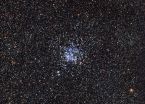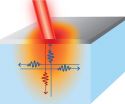(Press-News.org) Messier 11 is an open cluster, sometimes referred to as a galactic cluster, located around 6000 light-years away in the constellation of Scutum (The Shield). It was first discovered by German astronomer Gottfried Kirch in 1681 at the Berlin Observatory, appearing as nothing more than a fuzzy blob through the telescope. It wasn't until 1733 that the blob was first resolved into separate stars by the Reverend William Derham in England, and Charles Messier added it to his famous catalogue in 1764.
Messier was a comet hunter and the catalogue came into being as he was frustrated by constantly observing fixed, diffuse objects that looked like comets (for example, objects that we now know to be clusters, galaxies and nebulae). He wanted a record in order to avoid accidentally observing them again and confusing them with possible new comets. This particular stellar cluster was noted down as the eleventh such object — hence the name of Messier 11.
Open clusters are typically found lying in the arms of spiral galaxies or in the denser regions of irregular galaxies, where star formation is still common. Messier 11 is one of the most star-rich and compact of the open clusters, being almost 20 light-years across and home to close to 3000 stars. Open clusters are different to globular clusters, which tend to be very dense, tightly bound by gravity, and contain hundreds of thousands of very old stars — some of which are nearly as old as the Universe itself.
Studying open clusters is great way to test theories of stellar evolution, as the stars form from the same initial cloud of gas and dust and are therefore very similar to one another — they all have roughly the same age, chemical composition, and are all the same distance away from Earth. However, each star in the cluster has a different mass, with the more massive stars evolving much faster than their lower mass counterparts as they use up all of their hydrogen much sooner.
In this way, direct comparisons between the different evolutionary stages can be made within the same cluster: for example, does a 10 million year old star with the same mass as the Sun evolve in a different way to another star that is the same age, but half as massive? In this sense, open clusters are the closest thing astronomers have to "laboratory conditions".
Because the stars within open clusters are very loosely bound to one another, individuals are very susceptible to being ejected from the main group due to the effect of gravity from neighbouring celestial objects. NGC 6705 is already at least 250 million years old, so in a few more million years it is likely that this Wild Duck formation will disperse, and the cluster will break up and merge into its surroundings [1].
This image was taken by the Wide Field Imager on the MPG/ESO 2.2-metre telescope at ESO's La Silla Observatory in northern Chile.
INFORMATION:
Notes
[1] The alternative and evocative name for NGC 6705, the Wild Duck Cluster, came about in the 19th century. When the cluster was seen through a small telescope it was noticed that the brightest stars formed an open triangle pattern on the sky that resembled ducks flying in formation.
More information
ESO is the foremost intergovernmental astronomy organisation in Europe and the world's most productive ground-based astronomical observatory by far. It is supported by 15 countries: Austria, Belgium, Brazil, the Czech Republic, Denmark, France, Finland, Germany, Italy, the Netherlands, Portugal, Spain, Sweden, Switzerland and the United Kingdom. ESO carries out an ambitious programme focused on the design, construction and operation of powerful ground-based observing facilities enabling astronomers to make important scientific discoveries. ESO also plays a leading role in promoting and organising cooperation in astronomical research. ESO operates three unique world-class observing sites in Chile: La Silla, Paranal and Chajnantor. At Paranal, ESO operates the Very Large Telescope, the world's most advanced visible-light astronomical observatory and two survey telescopes. VISTA works in the infrared and is the world's largest survey telescope and the VLT Survey Telescope is the largest telescope designed to exclusively survey the skies in visible light. ESO is the European partner of a revolutionary astronomical telescope ALMA, the largest astronomical project in existence. ESO is currently planning the 39-metre European Extremely Large optical/near-infrared Telescope, the E-ELT, which will become "the world's biggest eye on the sky".
Links
Research papers on NGC 6705: http://adsabs.harvard.edu/cgi-bin/basic_connect?qsearch=NGC+6705&version=1
Photos of the MPG/ESO 2.2-m telescope: http://www.eso.org/public/images/archive/search/?adv=&subject_name=mpg
Photos of La Silla Observatory: http://www.eso.org/public/images/archive/category/lasilla/
Contacts
Richard Hook
ESO Public Information Officer
Garching bei München, Germany
Tel: +49 89 3200 6655
Cell: +49 151 1537 3591
Email: rhook@eso.org
Wild ducks take flight in open cluster
2014-10-01
ELSE PRESS RELEASES FROM THIS DATE:
Gene interacts with stress and leads to heart disease in some people
2014-10-01
DURHAM, N.C. – A new genetic finding from Duke Medicine suggests that some people who are prone to hostility, anxiety and depression might also be hard-wired to gain weight when exposed to chronic stress, leading to diabetes and heart disease.
An estimated 13 percent of people, all of whom are Caucasian, might carry the genetic susceptibility, and knowing this could help them reduce heart disease with simple interventions such as a healthy diet, exercise and stress management.
"Genetic susceptibility, psychosocial stress and metabolic factors act in combination to increase ...
Results of large-scale roll out of combination treatment for kala-azar in Eastern Africa
2014-10-01
Today in Bahir Dar, Ethiopia, at the occasion of the Leishmaniasis East Africa Platform meeting, which has gathered some 150 African and international leishmaniasis experts, results of a pharmacovigilance – or large-scale treatment safety and efficacy monitoring – plan, carried out by MSF, DNDi, and national partners in Kenya, Sudan, Uganda, and Ethiopia, were presented to key decision makers in order to boost patient access to treatment of kala-azar with the combination of Sodium Stibogluconate and Paromomycin (SSG&PM) in the region. In this large cohort of patients, treated ...
Long-acting insulin is safer, more effective for patients with Type 1 diabetes
2014-10-01
TORONTO, Oct. 1, 2014 – Long-acting insulin is safer and more effective than intermediate-acting insulin for patients with Type 1 diabetes, according to new research published in the BMJ.
Researchers looked at once-daily and twice-daily doses of both long- and intermediate-acting insulin, ranking their effectiveness, safety and cost-effectiveness.
"In patients with Type 1 diabetes, we found that long-acting insulin is superior to intermediate-acting insulin when it came to controlling blood sugar, preventing weight gain and treating severe hypoglycemia," said Dr. ...
All directions are not created equal for nanoscale heat sources
2014-10-01
Thermal considerations are rapidly becoming one of the most serious design constraints in microelectronics, especially on submicron scale lengths. A study by researchers from the University of Illinois at Urbana-Champaign has shown that standard thermal models will lead to the wrong answer in a three-dimensional heat-transfer problem if the dimensions of the heating element are on the order of one micron or smaller.
"As materials shrink, the rules governing heat transfer change as well," explained David Cahill, a professor of materials science and engineering at Illinois. ...
Microbes in Central Park soil: If they can make it there, they can make it anywhere
2014-10-01
Soil microbes that thrive in the deserts, rainforests, prairies and forests of the world can also be found living beneath New York City's Central Park, according to a surprising new study led by Colorado State University and the University of Colorado Boulder.
The research team analyzed 596 soil samples collected from across Central Park's 843 acres and discovered a stunning diversity of below-ground life, most of which had never been documented before.
Only 8.5 percent to 16.2 percent of the organisms discovered in the park soils, depending on their type, had been ...
Non-citizens face harsher sentencing than citizens in US criminal courts
2014-10-01
WASHINGTON, DC, September 29, 2014 — Non-Americans in the U.S. federal court system are more likely to be sentenced to prison and for longer terms compared to U.S. citizens, according to a new study.
"Much of the discussion in this area has centered around deportation, but increasing numbers of immigrants are being brought before criminal courts, and little is known about how they are treated once they are in the criminal justice system," said Michael T. Light, an assistant professor of sociology at Purdue University and the lead author of the study. "This is a major ...
Immunotherapy could stop resistance to radiotherapy
2014-10-01
Treating cancers with immunotherapy and radiotherapy at the same time could stop them from becoming resistant to treatment, according to a study published in Cancer Research* today (Wednesday).
The researchers, based at The University of Manchester and funded by MedImmune, the global biologics research and development arm of AstraZeneca, and Cancer Research UK, found that combining the two treatments helped the immune system hunt down and destroy cancer cells that weren't killed by the initial radiotherapy in mice with breast, skin and bowel cancers.
Radiotherapy ...
Is Australia prepared for Ebola?
2014-10-01
Australia needs to be proactive about potential disease outbreaks like Ebola and establish a national centre for disease control.
In an Editorial in the October issue of Australian and New Zealand Journal of Public Health, Allen Cheng from Monash University and Heath Kelly from the Australian National University question Australia's preparation for public health crises.
"Australia would do well to heed the lessons learned in other countries and be proactive in co-ordinating a consistent and outward looking response," the authors said.
"Australia needs a national disease ...
Targeted treatment could halt womb cancer growth
2014-10-01
A drug which targets a key gene fault could halt an aggressive womb cancer and shrink tumours, according to research published in the British Journal of Cancer*.
The scientists, from the Division of Gynaecologic Oncology at Yale School of Medicine funded by the National Institutes of Health, showed that the drug afatinib not only killed off uterine serous cancer cells after stopping their growth but also caused tumours to shrink.
The drug, a type of personalised medicine, attacks faults in the HER2 gene which lie at the heart of the cancer cells. This stops the disease ...
Third of countries struggling to meet the needs of aging population
2014-10-01
People around the world are living longer, but social policies to support their wellbeing in later life are lagging behind in many countries. This is according a new report by HelpAge International, developed in partnership with the University of Southampton.
More than a third of countries are falling significantly behind those at the top of the Global AgeWatch Index. It ranks 96 nations on the basis of the quality of life and social and economic wellbeing of older people (over 60s). The Index can also help governments to identify policies and institutional contexts that ...



